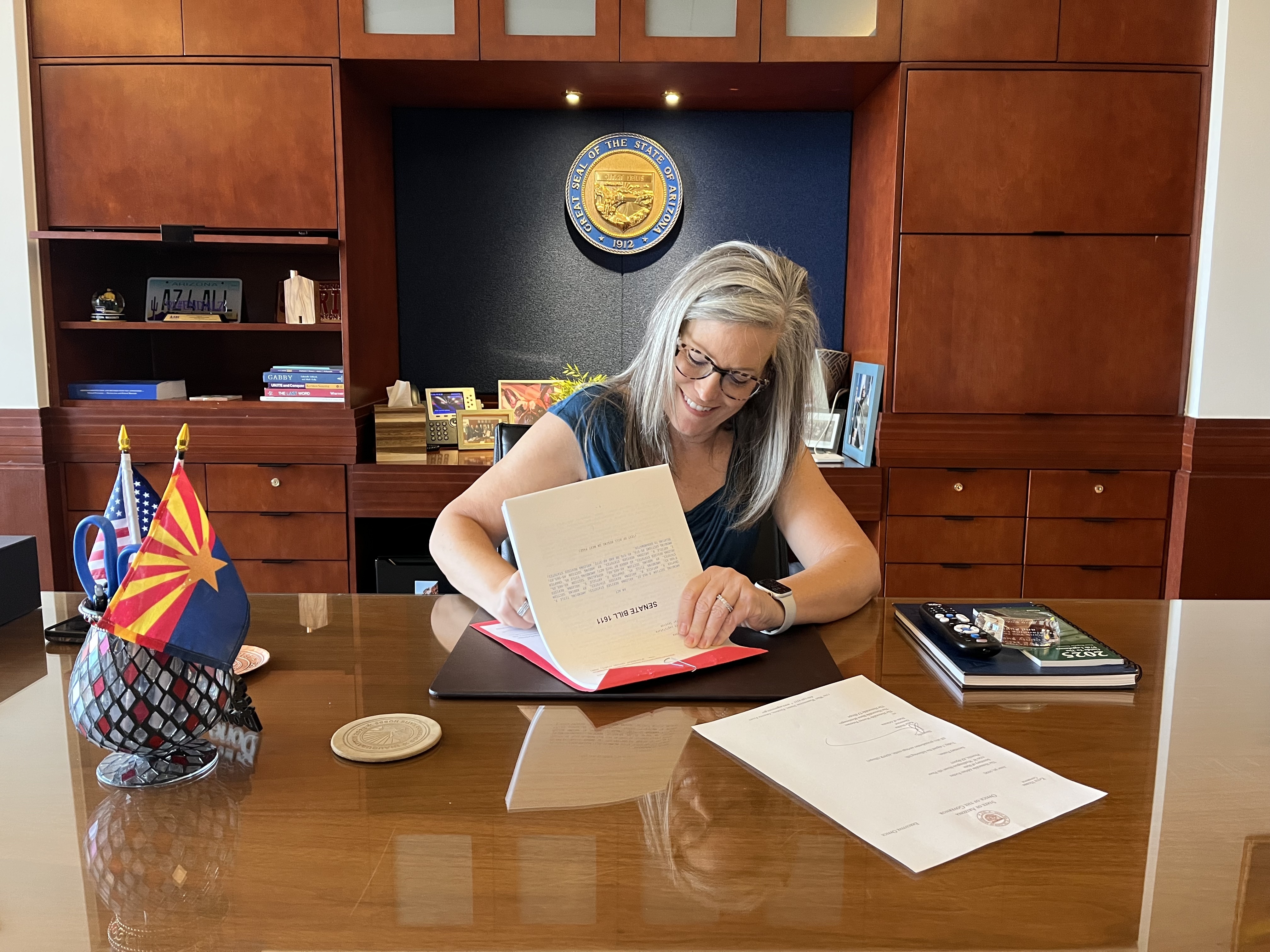Governor Katie Hobbs Brokers Deal for Historic, Bipartisan Water Conservation Legislation
News Release
The “Ag-to-Urban” program is projected to conserve nearly 10 million acre-feet over its lifetime and facilitate the development of tens of thousands of new homes
Phoenix, AZ - Today, Governor Hobbs announced the signing of Senate Bill 1611: Arizona’s “Ag-to-Urban” Groundwater Conservation Program, designed to save water while growing Arizona’s economy.
The legislation creates a voluntary program that allows high-water using irrigated lands to convert to lower water intensity development that generates massive water savings. The Arizona Department of Water Resources (ADWR) estimates the program could save millions of acre-feet of water over its lifetime.
SB 1611 passed the Arizona Legislature with a bipartisan supermajority in the Senate, and a bipartisan majority in the House. The Ag-to-Urban legislation is continued evidence Arizona is taking steps to reduce its water use and leading the nation in innovative water management. Governor Hobbs will continue work across the aisle and build upon this momentum as Arizona fights for a fair deal in Colorado River negotiations.
“The Ag-to-Urban water conservation legislation shows what we can achieve when state policymakers come together to focus on solving the problems that Arizonans care about most,” said Governor Katie Hobbs. “I have fought day in and day out to protect Arizona’s water while growing our economy, and I am proud to have brokered a bipartisan, historic water deal that will save millions of acre-feet of water, help lower the cost of housing, and create jobs. Arizona has long led the country in water management, and today we have shown that we will continue this legacy of addressing our most pressing challenges. But we aren’t done taking action. I will continue fighting to protect groundwater in rural Arizona so every community throughout our state will know they have the tools they need to secure their water future.”
“The passage of Senate Bill 1611 is an outstanding accomplishment, and testament to Governor Hobbs’ leadership in delivering solutions on water policy,” said former Governor Bruce Babbitt. “This legislation is good for our aquifers, good for our residents, and good for our farmers. It proves once again that Arizonans, by working together, can assure our water future. I commend all who worked to make this bipartisan legislation possible.”
“This Ag-to-Urban bill proves that Arizona can continue to come together when the situation requires to pass bipartisan, science-based water policy,” said Gila River Indian Community Governor Stephen Roe Lewis. “This is why I am confident that we will come together again to consider and approve the Post-2026 Guidelines package next year. I want to commend Governor Hobbs and her staff, and Tom Buschatzke, for their leadership in getting this done, as well as Senator Shope and Senate President Petersen for engaging in an open consultation process and listening to input from across the spectrum. Senator Sundareshan was also a key guiding voice and we appreciate her support and that of her colleagues in both bodies. A bipartisan conservation bill like this is a critical signal to all in the Basin that Arizona is going to do its part to address the crisis on the Colorado.”
“With Arizona's water resources scarce, Colorado River negotiations still ongoing, and climate change impacts increasing rapidly, it is more vital than ever that any changes to our groundwater management must ensure the security of our water resources,” said Senate Democratic Leader Priya Sundareshan. “This Ag-to-Urban bill, SB1611, represents a bipartisan compromise to allow grandfathered irrigation rights in our Active Management Areas to be converted to housing that uses less groundwater. Importantly, it contains many key guardrails designed to ensure that groundwater savings will be achieved over the next 100 years as a result of this program. I am pleased that the various parties were able to reach agreement here, and we must continue to strengthen our state groundwater management, including by supporting our replenishment obligations and by protecting rural groundwater.“
“The Ag-to-Urban plan represents nearly two years of painstaking negotiations between the Legislature, the Executive, stakeholders, water experts, water users, and community leaders. I’m proud of the end result,” said State Senator T.J. Shope. “Hard-working Arizonans will be able to pursue their American dream of homeownership as home supply increases in Maricopa and Pinal Counties and prices naturally ease. Our farmers, who are ready to retire, can reap the benefits of their land while also allowing the state to save water. The Ag-to-Urban plan is the most consequential piece of groundwater conservation legislation since the 1980 Groundwater Management Act. We are putting Arizona in a good position for Colorado River negotiations moving forward with the other basin states.”
“The Ag-to-Urban Program is based on the significant reduction in groundwater use that would otherwise continue if the grandfathered rights to irrigate farmland were not retired,” said ADWR Director Tom Buschatzke. “The strong bipartisan support for this program is an indication that Arizona can make the hard choices on water needed in an era of limits. Governor Hobbs, Arizona’s legislative leaders, and diverse stakeholders across the State are to be commended for working together on this difficult issue.”
“Arizona’s economic competitiveness depends on long-term water security. This legislation delivers real conservation while providing the business community with the certainty it needs to keep building and growing,” said Danny Seiden, President and CEO of the Arizona Chamber of Commerce & Industry. “It’s a smart, bipartisan, market-based solution that reinforces Arizona’s leadership in sustainable development and responsible water management — and it’s yet another example of the state’s strong stewardship as we head into critical Colorado River negotiations. We thank the Legislature and Gov. Hobbs for their work on this important effort.”
More information about the Ag-to-Urban Groundwater Conservation Program can be found here.

###
